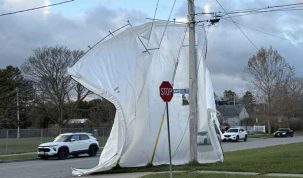By Cecilia Nasmith/Today’s Northumberland
The Haliburton Kawartha Pine Ridge District Health Unit has released a report – The Climate Change Health Vulnerability and Adaptation Assessment – that characterizes climate change as not just an environmental issue but “the biggest global threat of the 21st century.”
Analyzing the current and future impacts of climate change on HKPR residents, it identifies populations most at risk of negative impacts and provides recommendations on building adaptive capacity to reduce the associated health risks.
The report identifies climate hazards such as extreme temperatures, extreme weather, poor air quality, vector-borne diseases, compromised food and water safety, and solar ultraviolet radiation.
It also spotlights two key ways climate change affects health – it worsens existing health conditions and it can introduce new health threats in areas where they have not been previously observed.
“We must act now to protect the health and well-being, especially those at greatest risk,” Health Promoter Sue Shikaze urged.
In the face of a strong need for collaborative efforts to increase adaptive capacity and resilience, the report calls for actions from a variety of sectors – health care, environmental agencies, community organizations and policy makers – to address vulnerabilities and implement strategies to protect public health.
The announcement listed key findings in five areas.
Temperature – A significant increase in hot days is projected by 2050, leading to heat-related illnesses and mental-health impacts that can particularly affect older adults, people with chronic illnesses and those with limited income.
Extreme weather – Flooding, power outages, severe storms, wildfires and droughts that will increase in frequency will result in injuries, mental-health impacts and disruption to health-care services.
Vector-borne diseases – Longer warm seasons contribute to the spread of insects carrying diseases, such as black-legged ticks (Lyme disease) and mosquitoes (West Nile virus). Outdoor workers, older adults and individuals with weakened immune systems are at higher risk.
Safe food and water – Increased temperatures and precipitation pose threats to the safety and availability of drinking and recreational water, as well as food insecurity. People living on low incomes are particularly affected.
Air quality – Rising temperatures contribute to higher concentrations of air pollutants, worsening allergies and respiratory illnesses as well as increasing the risk of heart disease and stroke.
Traffic-related air-pollution zones affect a significant portion of the population, including those at schools and long-term-care facilities.
The health unit continues to offer programs that address the health risks posed by climate change, including public education, collaborative initiatives and advocacy for policy changes. Meanwhile, the next phase of this work is the development of a Climate Change Adaptation Action Plan that would provide a detailed roadmap for implementing adaptive measures to ensure the community’s future health and well-being.
The entire report can be read on the health unit website




















